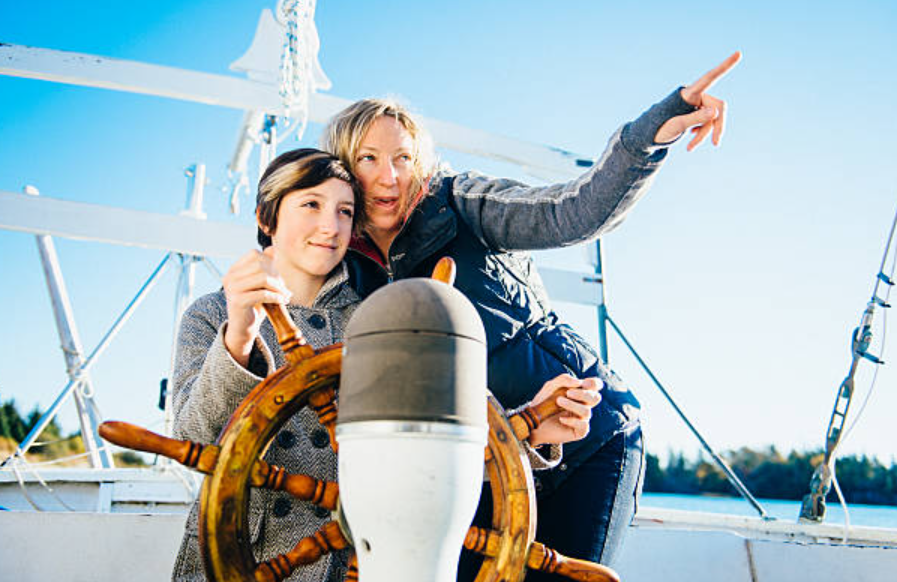Have you ever dreamed of sailing across the ocean, feeling the wind in your hair and the spray on your face, exploring new places and experiencing nature’s beauty? Sailing is one of the most rewarding and exhilarating activities you can do, and anyone can learn how to do it. Whether you want to sail for fun, for sport, or for adventure, this guide will help you get started on your sailing journey.
Sailing is a wonderful way to explore the world, enjoy nature, and have fun. If you want to sail for leisure, sport, or adventure, you need to learn the basics of sailing. In the next sections, we will cover some of the essential aspects of sailing that every beginner should know, such as sailing basics, sailing terminology, some sailing parts, nautical etiquette, seamanship, and resources. By the end of this guide, you will have a better understanding of what sailing entails and how to get started on your sailing journey.
Contents
Why Learn to Sail?
Sailing has many benefits and rewards, both for your body and your mind. Here are some of the reasons why you should learn to sail:
Physical benefits: Sailing is a great way to stay fit and healthy, as it involves using your muscles, balance, and coordination. You’ll burn calories, tone your body, and improve your cardiovascular health. Sailing also exposes you to fresh air and sunlight, which boost your immune system and mood.
Mental benefits: Sailing is a mental challenge that requires concentration, problem-solving, and decision-making. You’ll learn new skills, gain confidence, and overcome fears. Sailing also reduces stress and anxiety, as it helps you relax and focus on the present moment.
Emotional benefits: Sailing is a fun and enjoyable activity that brings you joy and satisfaction. You’ll feel a sense of freedom, adventure, and accomplishment as you sail. Sailing also connects you with nature, which enhances your well-being and happiness.
Unique experiences: Sailing offers you unparalleled experiences that you can’t get anywhere else. You’ll see amazing sights, such as sunsets, stars, dolphins, and whales. You’ll visit different places, such as islands, beaches, and ports. You’ll meet new people, such as fellow sailors, locals, and travelers. You’ll create memories that will last a lifetime.
Lifelong skill and community: Sailing is a skill that you can learn at any age and enjoy for the rest of your life. You’ll never get bored, as sailing is always different and challenging. You’ll also join a friendly and supportive community of sailors, who share your passion and values.
Getting Started: Learn Sailing Journey
If you’re interested in learning to sail, you might wonder how to begin. The good news is that sailing is accessible and affordable for anyone who wants to try it. Learn some of the steps you need to take to start your sailing journey.
Who can learn to sail?
The answer is anyone. Sailing is not limited by age, gender, or physical ability. As long as you have a desire to learn and a willingness to follow instructions, you can sail. Of course, you’ll need to be comfortable in the water and wear a life jacket at all times. You’ll also need to be aware of the risks and responsibilities involved in sailing, and follow the safety rules and regulations.
Different types of sailing

Sailing is a diverse and versatile activity that can suit different preferences and goals. There are various types of sailing, such as:
Dinghy sailing: This is sailing on a small boat that can fit one or two people. Dinghy sailing is ideal for beginners, as it teaches you the basic skills and techniques of sailing. It’s also fun and exciting, as you’ll feel the boat respond to your actions and the wind.
Keelboat sailing: This is sailing on a larger boat that has a keel, which is a fixed weight under the hull that provides stability. Keelboat sailing is suitable for intermediate and advanced sailors, as it involves more complex and sophisticated maneuvers. It’s also more comfortable and spacious, as you’ll have more room and facilities on board.
Racing sailing: This is sailing for sport and competition, where you’ll race against other boats and try to beat them. Racing sailing is challenging and thrilling, as it tests your skills, speed, and strategy. It’s also rewarding and social, as you’ll work as a team and celebrate your achievements.
Cruising sailing: This is sailing for leisure and travel, where you’ll sail for long distances and explore different destinations. Cruising sailing is relaxing and adventurous, as it allows you to enjoy the scenery, wildlife, and culture. It’s also flexible and personal, as you can choose your own pace and itinerary.
Where to learn
There are many options for learning to sail, depending on your budget, availability, and preference. Some of the most common options are:
Sailing schools: These are organizations that offer sailing courses and certifications for different levels and types of sailing. Sailing schools are professional and reputable, as they have qualified instructors, standardized curricula, and quality equipment. They are also convenient and accessible, as they have locations in many places and offer flexible schedules.
Sailing clubs: These are groups of sailing enthusiasts who share their passion and resources for sailing. Sailing clubs are friendly and supportive, as they have a community of sailors who can help you learn and improve. They are also affordable and beneficial, as they have membership fees that cover the use of boats and facilities.
Private lessons: These are sessions where you hire a private instructor to teach you how to sail. Private lessons are personalized and effective, as they cater to your specific needs and goals. They are also flexible and convenient, as they allow you to choose your own time and location.
Online courses: These are courses that you can take online, using videos, articles, and quizzes to learn the theory and basics of sailing. Online courses are easy and convenient, as they let you learn at your own pace and from anywhere. They are also cheap and useful, as they provide you with valuable information and tips.
Essential gear and equipment
To sail safely and comfortably, you’ll need some essential gear and equipment. Some of the items you’ll need are:
Life jacket: This is a vest that you wear over your clothes that keeps you afloat in the water. A life jacket is mandatory and lifesaving, as it prevents you from drowning in case of a capsize or fall. You should always wear a life jacket that fits you well and has a whistle and a light attached to it.
Sailing clothing: This is the clothing that you wear while sailing that protects you from the weather and the water. Sailing clothing should be comfortable and functional, as it should allow you to move freely and stay dry and warm. You should wear layers of clothing that are breathable, waterproof, and windproof, such as a base layer, a mid layer, and an outer layer. You should also wear a hat, sunglasses, and sunscreen to protect you from the sun.
Sailing shoes: These are the shoes that you wear while sailing that provide you with grip and stability. Sailing shoes should be comfortable and durable, as they should support your feet and withstand the wear and tear. You should wear shoes that are non-slip, non-marking, and quick-drying, such as sailing boots, deck shoes, or water shoes.
Sailing gloves: These are the gloves that you wear while sailing that protect your hands from blisters and injuries. Sailing gloves should be comfortable and flexible, as they should allow you to handle the ropes and the sails. You should wear gloves that are padded, grippy, and fingerless, such as sailing gloves or cycling gloves.
Basics of Sailing

Once you have the gear and equipment, you’re ready to learn the basics of sailing. Sailing is a skill that requires both knowledge and practice, so you’ll need to understand the theory and apply it on the water. Here are some of the topics you’ll need to learn:
Sailing terminology: Sailing has its own language, with many terms and expressions that describe the boat, the wind, the water, and the actions. Sailing terminology is important and useful, as it helps you communicate and understand what’s going on. You’ll need to learn the basic sailing terms, such as:
Bow: The front of the boat.
Stern: The back of the boat.
Port: The left side of the boat when facing the bow.
Starboard: The right side of the boat when facing the bow.
Hull: The body of the boat that floats on the water.
Mast: The vertical pole that supports the sails.
Boom: The horizontal pole that extends from the mast and holds the bottom of the mainsail.
Rudder: The movable blade at the stern that steers the boat.
Tiller: The handle that controls the rudder.
Sail: The fabric that catches the wind and propels the boat.
Sheet: The rope that controls the angle of the sail.
Halyard: The rope that hoists and lowers the sail.
Windward: The direction from which the wind is blowing.
Leeward: The direction to which the wind is blowing.
Tack: To change direction by turning the bow through the wind.
Jibe: To change direction by turning the stern through the wind.
Parts of a sailboat: A sailboat is a complex and sophisticated machine, with many parts and components that work together to make it sail. Parts of a sailboat are essential and functional, as they enable you to control and maneuver the boat.
Points of sail and sail trim: A point of sail is the angle between the direction of the boat and the direction of the wind. A sail trim is the adjustment of the sail to match the point of sail and the wind speed. Points of sail and sail trim are crucial and tricky, as they determine how fast and how well the boat sails.
Nautical Etiquette and Seamanship

Sailing is not only a skill, but also a culture. As a sailor, you need to respect the rules, traditions, and customs of the nautical world. Here are some of the most important aspects of nautical etiquette and seamanship that you should learn before you sail.
Right of Way Rules
When sailing, you need to be aware of the right of way rules, which determine who has the priority to maneuver and who has to give way in different situations. The right of way rules are based on the type, direction, and position of the vessels involved. Here are some of the basic right of way rules that you should know:
- A vessel that is not under command, such as a broken-down boat, has the right of way over all other vessels.
- A vessel that is restricted in its ability to maneuver, such as a fishing boat with nets, has the right of way over all other vessels except those not under command.
- A vessel that is constrained by its draft, such as a large ship in shallow water, has the right of way over all other vessels except those not under command or restricted in their ability to maneuver.
- A sailing vessel has the right of way over a power-driven vessel, unless the power-driven vessel is not under command, restricted in its ability to maneuver, or constrained by its draft.
- A sailing vessel on starboard tack (wind coming from the right side) has the right of way over a sailing vessel on port tack (wind coming from the left side).
- A sailing vessel that is overtaking another vessel has to give way to the vessel being overtaken, regardless of the tack or direction of the vessels.
Anchoring and Mooring
Anchoring and mooring are two ways of securing your boat when you are not sailing. Anchoring involves dropping an anchor from your boat to the seabed, while mooring involves attaching your boat to a fixed point, such as a buoy, a dock, or a pier. Here are some guidelines for anchoring and mooring in different conditions and tips for securing the boat safely:
- Choose a suitable spot for anchoring or mooring, taking into account the depth, bottom type, wind, current, tide, and traffic of the area. Avoid anchoring or mooring in restricted zones, channels, or near hazards.
- Use the appropriate anchor or mooring line for your boat size, weight, and type. Make sure the anchor or mooring line is in good condition and has enough length and strength to hold your boat.
- Lower the anchor or attach the mooring line slowly and carefully, making sure it is well set and secure. Avoid tangling, twisting, or crossing the anchor or mooring line with other lines or boats.
- Check the anchor or mooring line regularly for any signs of wear, damage, or slack. Adjust the anchor or mooring line as needed to maintain the proper tension and position of your boat.
- When leaving the anchorage or mooring, retrieve the anchor or detach the mooring line gradually and smoothly, making sure it is clear of any obstacles or other boats.
Environmental Responsibility
As a sailor, you have a responsibility to protect the marine environment and its wildlife. Sailing can have a negative impact on the ocean if you are not careful and respectful. Here are some of the ways you can minimize your environmental footprint and help preserve the marine ecosystems:
- Avoid dumping any waste, trash, or pollutants into the water. Dispose of them properly on land or at designated facilities.
- Use eco-friendly products and practices on your boat, such as biodegradable soap, solar panels, and water-saving devices.
- Avoid disturbing or harming any marine animals or plants, such as coral reefs, sea turtles, or dolphins. Keep a safe distance and do not touch, feed, or chase them.
- Participate in conservation efforts and initiatives, such as beach cleanups, marine education, or citizen science projects.
Resources & Next Steps
Now that you have learned some of the basics of sailing, you might be wondering how to take the next step towards your sailing adventure. The best way to learn to sail is to get hands-on experience and guidance from qualified instructors and mentors. Here are some of the resources and next steps that you can explore to further your sailing education and skills:
Local Sailing Schools & Clubs
One of the easiest and most affordable ways to learn to sail is to join a local sailing school or club. Sailing schools and clubs offer various courses and programs for different levels and interests of sailors, from beginners to experts. You can learn the theory and practice of sailing, as well as meet other sailors and join sailing events and activities. To find a sailing school or club near you, you can search online or ask around in your community.
If you are ready to take the plunge and learn to sail, don’t hesitate to sign up for a sailing course or program today. Sailing is a rewarding and enjoyable activity that can enrich your life in many ways. You can discover new places, experience new challenges, and make new friends. Sailing is not only a hobby, but also a lifestyle. So what are you waiting for? Start your sailing adventure today!
Conclusion
Sailing is a wonderful way to explore the world, enjoy nature, and have fun. Whether you want to sail for leisure, sport, or adventure, you need to learn the basics of sailing first. In this guide, we covered some of the essential aspects of sailing that every beginner should know, such as nautical etiquette, seamanship, and resources. We hope this guide has given you a better understanding of what sailing entails and how to get started on your sailing journey.
Sailing is a lifelong learning process that never gets boring or dull. There is always something new to learn, see, or do on the water. If you want to advance your sailing skills and knowledge, you can also take more advanced courses and certifications, such as coastal navigation, offshore sailing, or racing. Sailing is a skill that can open up many opportunities and possibilities for you.
Learn to sail today and embark on an amazing adventure that you will never forget. Sailing is not only a skill, but also a passion. Once you start sailing, you will never want to stop. Happy sailing!
